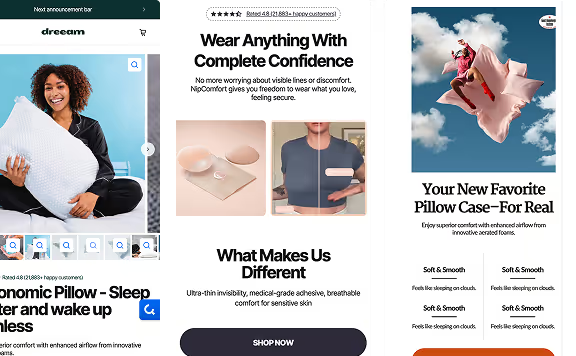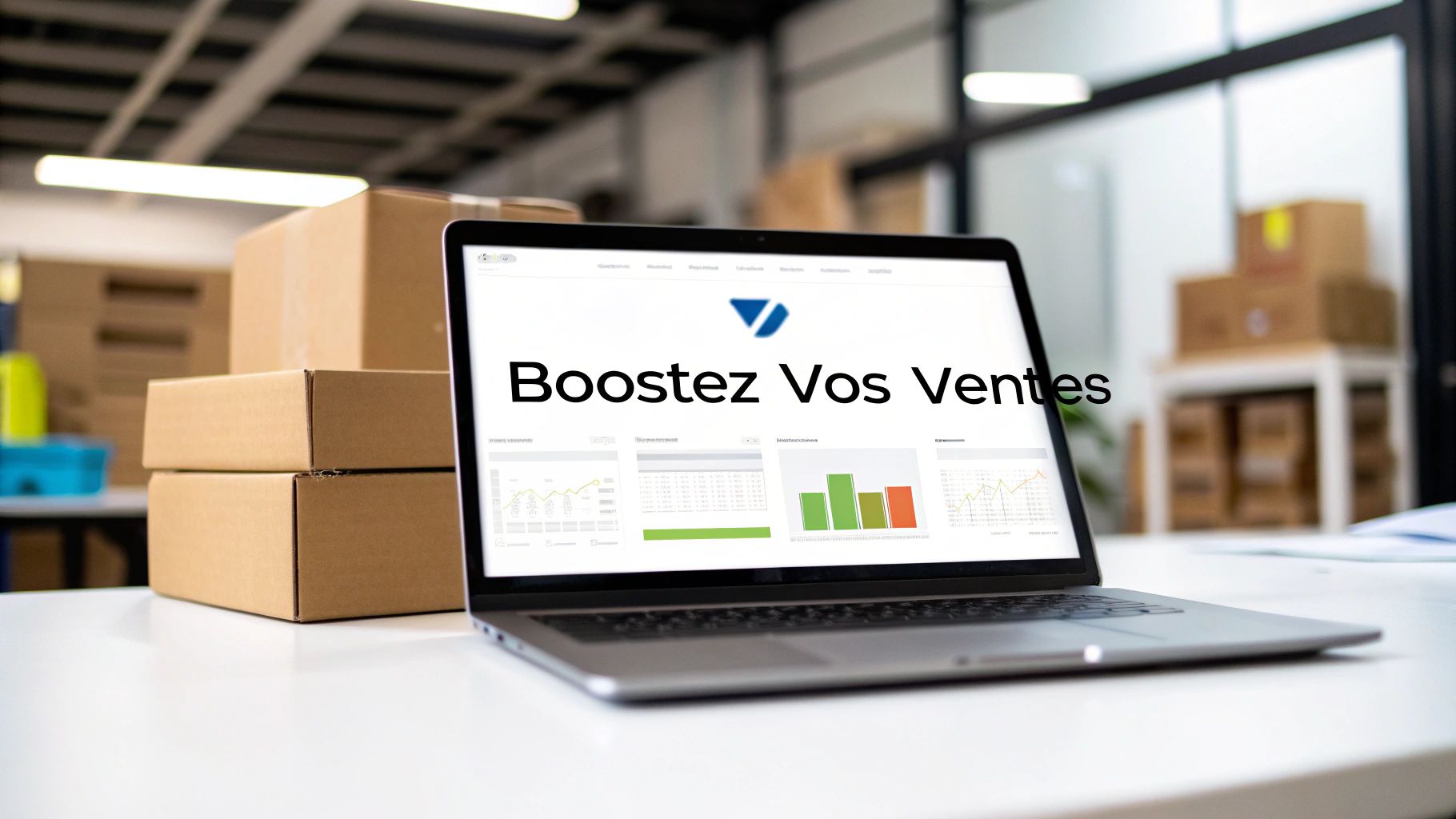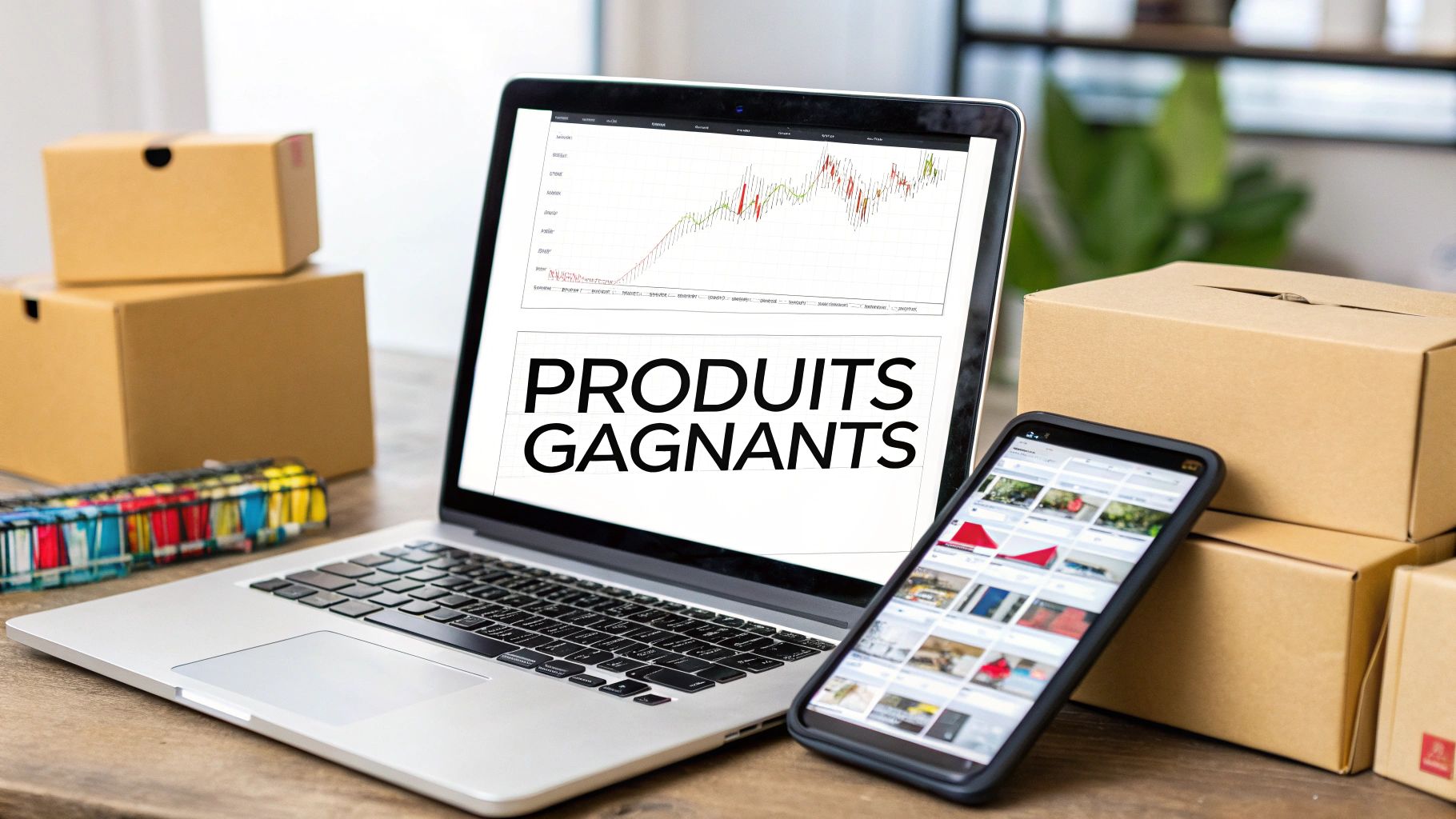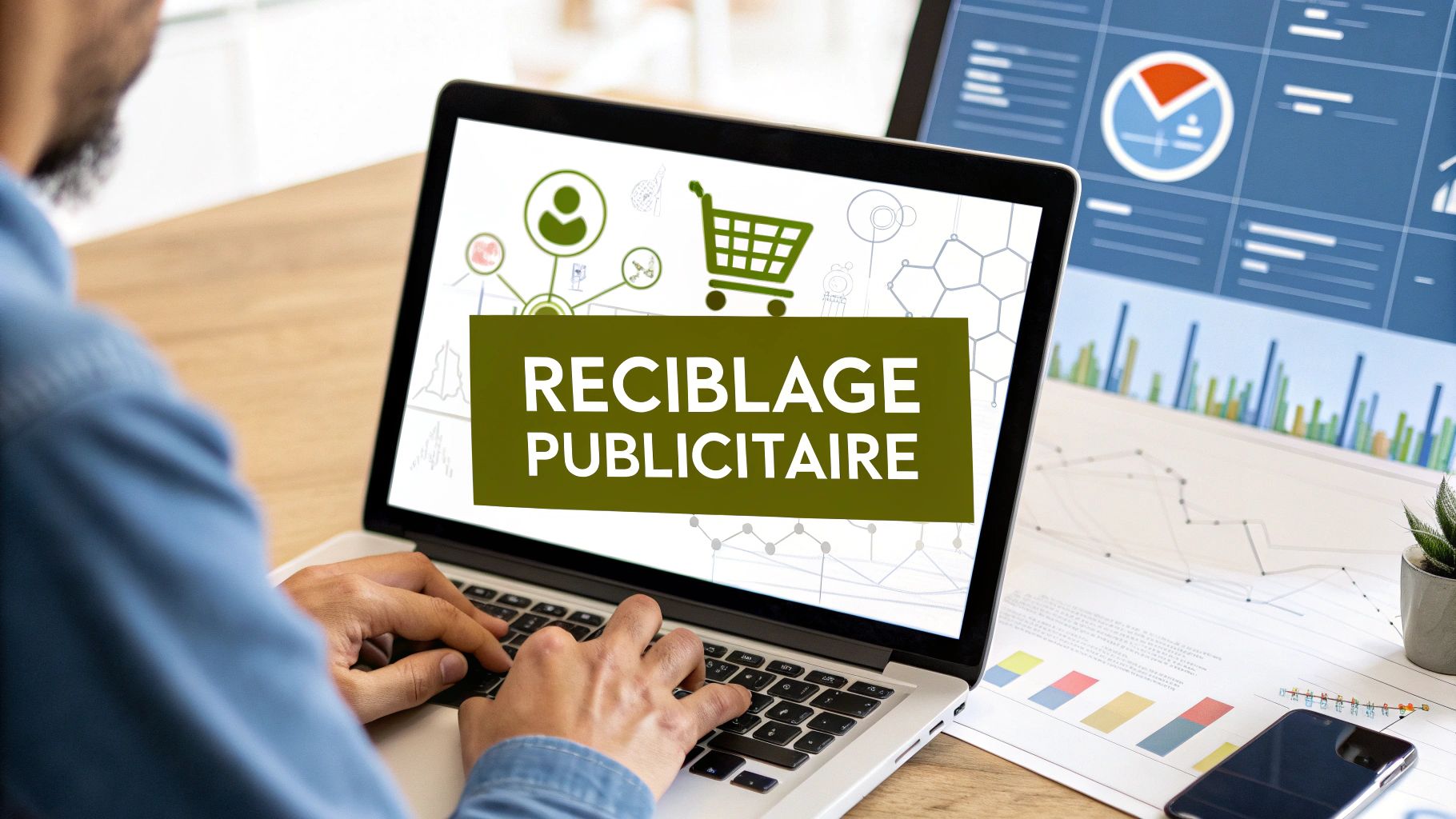E-commerce product research, the complete guide!
What you need to remember:
The 3 essential sources: advertising spying with Copyfy, marketplaces (Amazon, AliExpress) and social networks (TikTok, Instagram)
Criteria for a profitable product: price between 50-80€, minimum gross margin 40%, solves a concrete problem, rising trend
Mandatory validation: search volume >500/month, upward trend, some competitors active in advertising, test with an advertising budget of €50-100
Niches that are a hit: beauty & well-being, animal products, health & fitness, eco-responsible
The fatal error: launch without testing = losing money. ALWAYS order a sample before selling
Find your product quickly with Copyfy, free to try!
Do you want to launch your online store but you don't know what product to sell? Do you spend hours scrolling through AliExpress without knowing if your idea will really work? We understand you perfectly. The success of an e-commerce store does not depend on your website or logo, but on the product you choose to sell.
The truth is that 80% of dropshipping failures come from the wrong product choice. Many get started by blindly copying what they see on TikTok, without validating real demand, competition, or margins. Result? Hundreds of euros lost in advertising for nothing.
In this guide, we share with you a concrete, tested and proven method for finding winning products in 2025. You will discover the tools used by professionals, the precise criteria for a profitable product, and how to validate your idea before investing a euro.
Find your product quickly with Copyfy, free to try!
What is product research in e-commerce?
Product research is the process that allows you to identify products that have real sales potential before offering them in your store. It is the difference between having a simple idea and having a validated product that will generate sales.
Many people confuse “having a product idea” with “having a winning product.” One idea is, “I think this yoga mat could be liked.” A validated product is “I have verified that there are 5,000 searches per month, 10 competitors advertising on it, and a margin of 40%”.
The complete product research cycle is divided into 4 steps:
- Ideation : find product ideas through various sources
- Validation : check that there is demand and that it is profitable
- Test : launch a first campaign to measure real interest
- Launch : scale what works
The classic mistake? Jump directly from idea to launch without going through validation. It's the best way to lose money fast.
Find your product quickly with Copyfy, free to try!
The main methods to find a winning product
1. Observe trends
Trends are your best allies in identifying fast-growing products. The objective? Catching a wave before it becomes a tsunami of competition.
Use these tools to detect rising trends:
- Google Trends : you type in a keyword (ex: “facial cleansing brush”) and you see if the curve has increased over the last 3-6 months. If it's stable or up, that's a good sign.
- TikTok Creative Center : this free tool shows you which videos and hashtags are exploding right now. It's a gold mine for detecting what's going to go viral.
- Pinterest Trends : Pinterest is 3 to 6 months ahead of other platforms. What's trending on Pinterest today will be trending on Instagram and TikTok tomorrow.
Practical advice: always filter by country (France, Belgium, Switzerland) and look at seasonality. A product that rises in October may be linked to Christmas, be careful not to launch too late.
Find your product quickly with Copyfy, free to try!
2. Explore marketplaces
Marketplaces like Amazon, Etsy or AliExpress are living databases of what is being sold actually. No theory here, only concrete figures.
Here's how to use them:
On Amazon:
- Go to the “Best Sellers” section of your category
- Look at the products with over 1,000 reviews and rate those whose reviews are increasing rapidly (a sign of recent sales)
- Analyze the average prices: between €40 and €80, this is the ideal zone for dropshipping
On AliExpress:
- Use the “Dropshipping Center” (space dedicated to dropshippers)
- Filter by “Orders” and sort in descending order
- A product with +1,000 orders and shipping from Europe is a good candidate
On Etsy:
- Look for handmade or niche products
- If you see few competitors but a lot of sales, it's a jackpot
MarketplaceData to analysisWinning product signalAmazonNumber of reviews, monthly evolution+1000 reviews with growthetsySales, reviews, competitionHigh demand, few sellersAliexpressOrders, prices, origin+1000 orders, shipping EU
Find your product quickly with Copyfy, free to try!
3. Spy on successful ads (Ad Spy)
If a store has been spending money advertising for several weeks on a product, it is because it is profitable. Point. Nobody pays to advertise a product that doesn't sell.
Ad espionage tools allow you to see exactly what is working with your competitors:
- Use specialized tools like Minea or Dropispy. They're effective, but often require separate subscriptions, which increases your fixed costs before you've even made a sale.
- Use an integrated platform.
That's why we have integrated an advertising espionage tool directly into Copyfy. The objective is to centralize your search: you detect a winning advertisement, you analyze the competing store, and you find the supplier... all in the same place, without multiplying subscriptions.
How do I use Copyfy?
- Filter by engagement (comments + shares)
- Watch the ads that have been running since more than 30 days (sign of profitability)
- Analyze the video format, script, marketing angles
- Note the products that come back regularly
Chez Copyfy, we have directly integrated a high-performance advertising espionage tool so that you can detect winning ads in a few clicks, without multiplying subscriptions.
Find your product quickly with Copyfy, free to try!
4. Validate the request with SEO tools
Trends and ads are good. But Are people really looking for this product on Google? That's where SEO tools come in. Very useful in case you want to advertise on Google Ads and place yourself at the top of the search results organically
What to check:
- The monthly search volume (how many people are looking for this product)
- La SEO difficulty (is it easy or difficult to position yourself)
- Les related keywords (to understand specific needs)
The tools to use:
- Ubersuggest (free, perfect for getting started)
- AnswerThePublic (to see what questions people are asking)
- Ahrefs or Semrush (more professional, but not free)
Concrete example:You find the product “anti-stress collar for dogs”
- Search volume: 2 400/month
- SEO difficulty: low (20/100)
- Related keywords: “calming dog collar”, “pheromone necklace”
➡️ It's a great signal! There is demand, little competition, and variations to be exploited.
Find your product quickly with Copyfy, free to try!
5. Find products on social networks
Social networks have become real gold mines for product research. What goes viral on TikTok can generate tens of thousands of euros in a few weeks.
Where to look?
- TikTok : hashtags #TikTokMadeMeBuyIt, #AmazonFinds, #MustHave
- Instagram Reels : follow the curation accounts produced
- YouTube Shorts : unboxings and product tests are a hit
Social Commerce (buy directly on platforms) exploded in 2025. The products that are buzzing on TikTok Shop or Instagram Shopping are often bombs for classic dropshipping.
Pro tip: Join Facebook groups in your niche and see what people are really talking about. What are their problems? Their frustrations? That's where the best products are hidden.
Find your product quickly with Copyfy, free to try!
The criteria for a winning product
Now that you know where to look, you still need to know What to look for. Not all products are created equal. Here are the criteria that make the difference between a flop and a success.
Economic criteria
Ideal selling price: between €40 and €200
- Below €40, your margin will be too low to make advertising profitable
- Above €200, you will have a hard time convincing on an impulse purchase
- The sweet spot? Between 50€ and 80€
Target gross margin: minimum 30-40%
Simple formula:
Gross margin = (Selling Price - Buying Cost - Shipping)/Selling Price × 100
Example:
- Sales price: 50€
- Product cost + shipping: 15€
- Gross margin: (50 - 15)/50 = 70%
➡️ With a 70% margin, you can spend up to 30-40% on advertising and remain profitable. That's what allows you to scale.
Market criteria
A winning product should check these boxes:
✅ Solves a concrete problem (not just “it's pretty”) ✅ Unique or differentiable (you can create a specific marketing angle) ✅ Rising trend (not a saturated or declining market) ✅ Fast delivery possible (ideally from Europe) ✅ No legal restrictions (attention to CE standards, electrical products, etc.) ✅ Visual appeal (the product sells well in video/photo)
The criterion that everyone forgets: the ease of creating content. If your product is not “Instagrammable” or difficult to stage, you will struggle with advertising.
Find your product quickly with Copyfy, free to try!
Profitable niches in 2025
Some niches perform better than others. Here are the ones that are trending right now and will continue to explode in 2025:
NicheProduct ExamplesSearch VolumeAverage MarginBeauty & well-beingFace serum, LED brush, gua sha15k-25k/month 40-50%Animal productsAnti-pull harness, water fountain, interactive toys 10k-20k/month 30-40%Health & fitnessResistance bands, massage roller, posture corrector8k-15k/month 35-45%Home officeLaptop stand, LED desk light, ergonomic chair 12k/month 30-35%Eco-responsibleFilter bottle, reusable cottons, bamboo toothbrush 5k-10k/month 35-40%Tech gadgetsWireless earbuds, wireless charger, tracker object20k+/month 25-35%
Why do these niches work?
- They meet real and daily needs.
- The products are simple to understand and to present
- There is a high potential for viral content (transformations, before and after)
- The target is broad and accessible in advertising
The beauty and wellness niche remains the most accessible for beginners: high demand, comfortable margins, and young women (18-35) are very active online and buy easily.
Find your product quickly with Copyfy, free to try!
How to validate a product before launching it
Found an idea that you like? Perfect. Now, don't get started right away. Validation is the step that will save you hundreds (or even thousands) of euros.
Here is the 6-step process:
1. Define the problem solved
Ask yourself this question: “What concrete problem does this product solve?”
If you can't answer clearly in one sentence, give up. Gadget products with no clear purpose no longer work in 2025.
2. Study the demand using keywords
Use Ubersuggest or Google Keyword Planner:
- Minimum volume: 500 searches/month
- Ideal: 2,000-10,000 searches/month
- Trend: stable or increasing
3. Check the competition
Competition is NEEDED. If no one is selling this product, that is a bad sign (no demand or logistical problem).
Take a look:
- How many stores sell it?
- How long have they been advertising?
- What are their marketing angles?
The sweet spot: 5 to 15 competitors active in advertising (proof that it works, but not saturated).
4. Order a sample
NEVER sell a product that you have not tested yourself. That is the golden rule.
Order 1 or 2 samples for:
- Check the actual quality
- Test the delivery time
- Take authentic photos/videos
- Understand the strengths to highlight
A poor quality product will destroy your reputation and your conversion rates. Quality is what makes the difference between a short-term business and a sustainable brand.
5. Start a mini advertising test
Before investing big, test with 50-100€ on Facebook Ads or TikTok Ads:
- Create a simple video (use AI or your smartphone)
- Broad target (general interests)
- Measure it CTR (click through rate) And the CPM (cost per 1000 impressions)
Objective:
- CTR > 2% = good sign
- CPM < €15 = interested audience
- A few additions to the basket = validation
6. Measure real interest
Analyze your test data:
- How many clicks to the product page?
- How many additions to the basket?
- How many purchases?
- What comments under the ad?
If you have at least 3-5 sales with a €100 advertising budget, you have a winning product in your hands.
📋 Download our checklist “Validate your product in 6 steps” to have all the criteria in front of you when you analyze a product.
Find your product quickly with Copyfy, free to try!
Mistakes to avoid
We have supported thousands of e-retailers at Copyfy. Here are the mistakes we see again and again:
Mistake #1: Not testing before investing
Have you found a product that you think is perfect? Great. But Your first 50 euros in advertising will tell you if you are right or wrong. Do not order 500 units until you have validated with real sales.
Mistake #2: Underestimating the real costs
Many people calculate: “I sell €50, I buy €10, I make a €40 margin.”
Wrong Here are the real costs:
- Product: 10€
- Shipping: 5€
- Advertising: 15-20€ (on average)
- Platform fees (Shopify, etc.): €1
- Returns/after-sales service: 2-3 €
➡️ Real margin: 7-12 € on a sale at 50€
Never forget that in your calculations.
Mistake #3: Copying a saturated product
“I'm going to sell rings that change color, it works for everyone!”
Yes, it worked... 2 years ago. Now it's saturated. You will have to pay for your ads 3x more for 3x worse results.
Look for products that are in a growth phase, not in a phase of decline.
However, there are cases where “saturated” products work well by changing the target audience and marketing angle.
Mistake #4: Forgetting differentiation
If you sell exactly the same thing as 50 other stores, why would we buy from you?
You need to have a different angle:
- Better content (photos, videos)
- A unique positioning (e.g. “special active moms”)
- A bundle or an exclusive offer
- A better customer experience
Mistake #5: Neglecting the product sheet
You can have the best product in the world, if your product sheet sucks, you won't sell anything.
A good sheet contains:
- A clear title with the main benefit
- 5-7 professional photos (including at least 1 lifestyle)
- A demonstration video
- A profit-oriented description (not characteristics)
- Customer reviews (even if you're just starting out, find a way to get them)
Find your product quickly with Copyfy, free to try!
Recommended tools 2025
You don't need 15 tools. Here are the ones that are really worth it:
🔍 Product search:
- Copyfy (our all-in-one platform: ad espionage + store analysis + AI site generation)
- Exploding Topics (to detect emerging trends)
📊 Market validation:
- Google Trends (free, essential)
- Ubersuggest (for keywords, free version is enough)
- TikTok Creative Center (free, real-time trends)
📦 Sourcing:
- Spocket (EU and USA suppliers, fast shipping)
- Zendrop (dropshipping automation)
- BigBuy (European wholesaler, pro quality)
🎨 Content creation:
- Canva (visual design, templates ready)
- CapCut (mobile/desktop video editing, free)
- Replicate or Runway (AI video generation to create ads quickly)
At Copyfy, we built the platform we would have liked to have had when we started: everything centralized, simple, and without breaking the bank in multiple subscriptions.
Find your product quickly with Copyfy, free to try!
What you need to remember:
Product research is not magic. It is a method.
Remember the 3 pillars:
- Identifying trends (via tools, social networks, competing ads)
- Validate the request (keywords, search volume, competition)
- Test quickly (mini advertising budget, product sample, results analysis)
The perfect product does not exist. What exists is the validated product that you will improve continuously thanks to customer feedback.
Now you have everything you need to find your first winning product. The most important thing? Take action today. Start by analyzing 3 products using the method in this guide. Write everything down in a file. Compare. Pick the best. Start a test.
Whoever acts fast and tests intelligently wins. Anyone who thinks for 6 months stays at the starting point.
Ready to find your product?
👉 Try Copyfy free for 5 days and access our winning product base + advertising espionage + AI store generation
Need help? Join our Discord community where thousands of online retailers help each other every day.
















